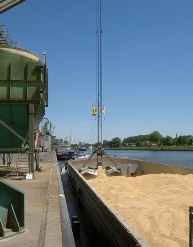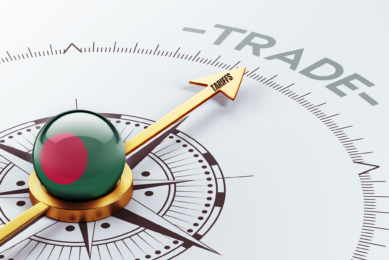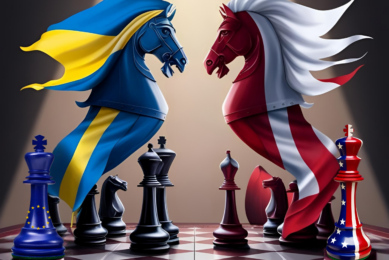By Dick Ziggers
Pedro Corrêa de Barros stated that “this is the right time for our Farm Ministers to review the CAP affecting
the competitiveness and sustainability of our EU livestock sector”. With a view to needing to increase the production of food of animal origin on a global scale by 50% by 2050, Corrêa de Barros underlined that it is Europe’s obligation to realise the full potential of its agricultural resources in a sustainable manner, allowing the use of modern technology to boost yields and to raise production efficiency of ecologically intensive livestock production.
“Fefac members are totally committed to supporting EU livestock producers in a very difficult economic situation by encouraging policies which safeguard the access to sustainable and competitive feeding stuffs”, Corrêa de Barros said.
He noted with satisfaction that the global Roundtable for Responsible Soy, RTRS, adopted the groundbreaking global principles and criteria for the production of responsible soy at its 3rdGeneral Assembly meeting in Campinas, Brazil, on 28 May 2009. He stressed that the new standard would ensure the protection of high-value conservation areas in the main production zones for soybeans.
Corrêa de Barros stressed that “private-public partnerships such as the RTRS are a crucial instrument to reach global policy targets linked to climate change. They can provide mainstream solutions for the farming sector at a minimum cost”.
He also stressed that in a market environment which will see a continuing trend to rising raw material, it is extremely important that the EU supports the innovation capacity of the EU agro-food industry through target research programmes and a tailor-made policy protecting intellectual property rights as laid down in the new regulation for the placing on the market and use of feed. He underlined that “The feed industry key contribution to enhance the competitiveness and sustainability of livestock farmers lies in its capacity to get the best nutritional value from co-products of the food industry; this know-how needs to be protected to allow feed producers and farmers reaching sustainability objectives linked to the reduction of green house gas emissions through better feed formulations”.
Fefac position on CAP beyond 2013
The EU livestock sector is the most important customer of food industry by-products for food use, in particular from arable crop processing. Feed is the most important production factor for livestock producers. For these
reasons, animal feed must be regarded as an essential link between vegetable and animal production. Fefac representing the EU compound feed industry is committed to getting involved in the debate on the future evolution of the EU Common Agriculture Policy from a feed & food chain perspective. Below is the state of the primary reflections. The challenges that the EU agricultural sector will face in 2013 and beyond are likely to be similar to those identified in the framework of the Health Check of the CAP, i.e.:
• A growing global demand for agricultural products, driven by an increasing world population, a growing per capita consumption of animal products and the additional demand for biomass for energy production purposes. Being amongst the most favoured global areas for agriculture production, EU agriculture must contribute to meeting the increasing global demand and therefore produce more;
• A limitation of the possibility to mobilise additional natural resources for farming purpose, in particular land, and the necessity to preserve existing resources through sustainable agriculture production models; the EU agriculture must therefore be more efficient;
• A variability of the agronomic conditions amplified by climate change and triggering huge seasonal variations in agricultural output and therefore in the availability of raw materials for the feed and food industry; the EU agricultural policy must secure the supply of agricultural goods to the feed and food industry;
• A multifunctional role of the EU farmers going beyond the production of agricultural goods, e.g. preservation of landscape; agricultural activity must be developed everywhere in the EU;
• A dramatic volatility of market prices for agricultural products and also for products of intermediate consumption (fertilisers, feed, energy, etc.); the EU agriculture must be competitive and economically viable for EU farmers and related sectors.
In addition, EU agriculture must continue its basic mission of producing safe agricultural goods, offering a large choice of different types of products with different qualities, meeting the demands of the EU and global consumers at affordable prices. In summary, EU agriculture must produce more, better, everywhere and at an affordable price.
What’s the aim?
What should the future evolution of the EU Common Agriculture Policy aim at? When reviewing the CAP, decision makers should address these challenges, while keeping in mind the key objectives of the Rome Treaty, i.e. stabilisation of prices, food security, co-responsibility and principle of cohesion.
In Fefac’s opinion, any EU common Agriculture Policy should:
• Reaffirm that the role of the EU agriculture is first and foremost to produce agricultural goods and to meet the demand of the food & feed chain as a matter of priority to any other destination;
• Promote efficient production systems, meaning rehabilitation of ecologically intensive production systems;
To identify the bottlenecks hampering access to the most efficient technologies and the inconsistencies.
• Encourage a high added value feed and food chain:
– To promote a market oriented agriculture, meeting the specifications of the feed and food industry;
– To implement tools enabling to supply the feed and food industries in case the EU production would not be sufficient or to control extreme price fluctuations;
– To encourage the processing of agricultural products in the EU and therefore the export of high added value products.
• Help the EU livestock sector remaining competitive vs. third country competitors: this means:
-To further rebalance the direct support in favour of livestock producers in order to avoid that the “EU livestock sector is exported”;
– To ensure that any production system relies on its own market to develop and that any difference in public support is based on scientific criteria only;
– To promote EU standards vis-à-vis the EU consumers and third country customers;
– To place the EU livestock sector in a competitive position to meet the market demand with EU produced animal products.
• Ensure a decent revenue to farmers and related activities: this means:
– To guarantee support in the longer term;
– To maintain certain management measures for markets of strategic importance for the EU to encourage farmers to produce for those markets.
• Help the EU farming sector meeting the challenge of adaptation and mitigation of climate change. This means:
– To redirect public support to investments linked to adaptation to climate change;
– To empower DG Agriculture to play a leading role in defining measures for mitigation of the impact of EU agriculture on climate change.
Source: Feed Tech magazine Volume 13. No. 6












